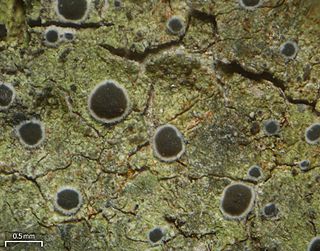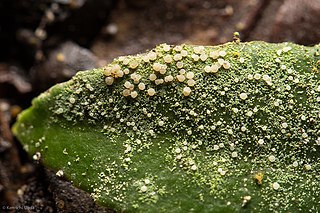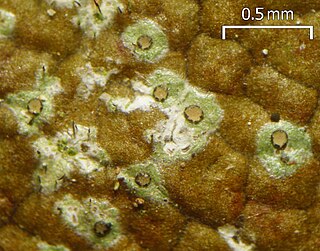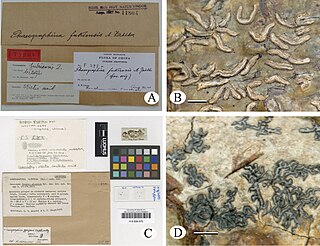
The Pilocarpaceae are a family of crustose lichens in the order Lecanorales. The species of this family have a cosmopolitan distribution and have been found in a variety of climatic regions. Pilocarpaceae was circumscribed by Alexander Zahlbruckner in Adolf Engler's influential 1905 work Die Natürlichen Pflanzenfamilien.

Bacidina is a genus of lichens in the family Ramalinaceae. It was circumscribed by Czech lichenologist Antonín Vězda in 1990, with Bacidina phacodes assigned as the type species. Vězda included 11 species in Bacidina, which was originally classified in the Lecideaceae. These species had previously been placed in genus Bacidia.

The Gomphillaceae are a family of lichen-forming fungi in the order Graphidales. Species in this family are found mostly in tropical regions.

Fellhanera is a genus of mostly leaf-dwelling lichens in the family Pilocarpaceae. The genus, circumscribed by lichenologist Antonín Vězda in 1986, honours Austrian lichenologist Josef Hafellner.

Calopadia is a genus of foliicolous (leaf-dwelling) lichens in the family Pilocarpaceae. It was circumscribed by Czech lichenologist Antonín Vězda in 1986.

Byssoloma is a genus of leaf-dwelling lichens in the family Pilocarpaceae.
Badimia is a genus of foliicolous (leaf-inhabiting) lichens in the family Ramalinaceae.
Sporopodium is a genus of lichen-forming fungi in the family Pilocarpaceae.
Caprettia is a genus of lichenized fungi in the family Monoblastiaceae. The genus was circumscribed by Augusto Chaves Batista and Heraldo da Silva Maia in 1965, with Caprettia amazonensis assigned as the type species.
Aderkomyces is a genus of lichens in the family Gomphillaceae. It was circumscribed by Brazilian mycologist Augusto Chaves Batista in 1961.
Arthotheliopsis is a genus of fungi in the family Gomphillaceae. It has 5 species. The genus was circumscribed by Finnish lichenologist Edvard August Vainio in 1896, with A. hymenocarpoides assigned as the type species.
Calenia is a genus of lichen-forming fungi within the family Gomphillaceae.
Echinoplaca is a genus of lichens in the family Gomphillaceae.
Ferraroa is a single-species genus in the family Gomphillaceae. It is a monotypic genus, containing the single species Ferraroa hyalina, a foliicolous (leaf-dwelling) lichen. This species was originally described by Robert Lücking in 1997 as Gyalideopsis hyalina. The type specimen was collected from leaves of Inga oerstediana in Costa Rica. Lücking, Emmanuël Sérusiaux, and Antonín Vězda transferred the taxon to the newly circumscribed genus Ferraroa in 2005 after molecular phylogenetic analysis showed it to belong to a unique lineage. The generic name Ferraroa honours Argentinian lichenologist Lidia Itatí Ferraro, "for her many contributions to lichenology in southern South America, and to our knowledge of Gomphillaceae".
Gyalectidium is a genus of lichen-forming fungi in the family Gomphillaceae. A 2020 estimates placed 52 species in the genus. The genus was circumscribed by Swiss lichenologist Johannes Müller Argoviensis in 1881. He included 3 species: G. xantholeucum, G. dispersum, and G. filicinum; the last of these is now the type species of the genus.
Rubrotricha is a genus of lichen-forming fungi in the family Gomphillaceae. It is a monospecific genus, containing the single species Rubrotricha helminthospora.

Tricharia is a genus of lichens in the family Gomphillaceae. It has an estimated 30 species.
Brasilicia is a genus of leaf-dwelling lichens in the family Pilocarpaceae. It has 6 species. The genus was circumscribed in 2008 by lichenologists Robert Lücking, Klaus Kalb, and Emmanuël Sérusiaux, with B. brasiliensis assigned as the type species. The genus was originally circumscribed as monotypic; Edit Farkas transferred five species to Brasilicia from Bacidia in 2015.
Arthotheliopsis serusiauxii is a species of leaf-dwelling lichen in the family Gomphillaceae. It was first formally described as a new species in 1997 by Robert Lücking, as a member of genus Echinoplaca. The type specimen was collected in Costa Rica, growing on the leaves of a dicotyledon. The specific epithet honours Belgian lichenologist Emmanuël Sérusiaux. In 2005, Lücking, Sérusiaux, and Antonín Vězda transferred it to genus Arthotheliopsis after a molecular analysis of the Gomphillaceae helped to clarify the phylogenetic relationships in the family.

Graphidales is an order of lichen-forming fungi in the class Lecanoromycetes. It contains 6 families, about 81 genera and about 2,228 species. Family Graphidaceae are the largest crustose family within Graphidales order comprising more than 2000 species, which are widely distributed in tropical and subtropical regions of the world.






